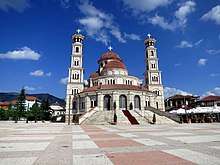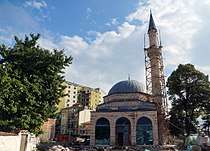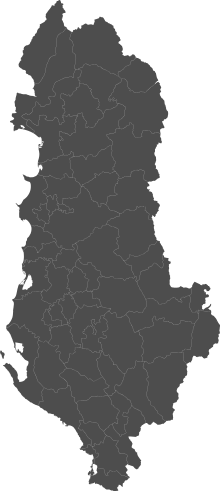Korçë
Korçë (IPA: [kɔ:ɾtʃ(ə)]; (definite Albanian form: Korça), other names see below) is a city and municipality in southeastern Albania, and the seat of Korçë County. It was formed at the 2015 local government reform by the merger of the former municipalities Drenovë, Korçë, Lekas, Mollaj, Qendër Bulgarec, Vithkuq, Voskop and Voskopojë, that became municipal units. The seat of the municipality is the city Korçë.[1] The total population is 75,994 (2011 census),[2] in a total area of 806.67 km2 (311.46 sq mi).[3] The population of the former municipality at the 2011 census was 51,152.[2] It is the sixth largest city in Albania. It stands on a plateau some 850 m (2,789 ft) above sea level, surrounded by the Morava Mountains.
Korçë Curceaua Goritsa | |
|---|---|
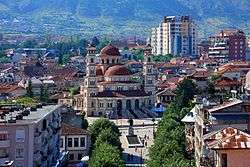 View of The Resurrection Cathedral | |
 Emblem | |
| Nickname(s): City of the Serenades
Little Paris | |
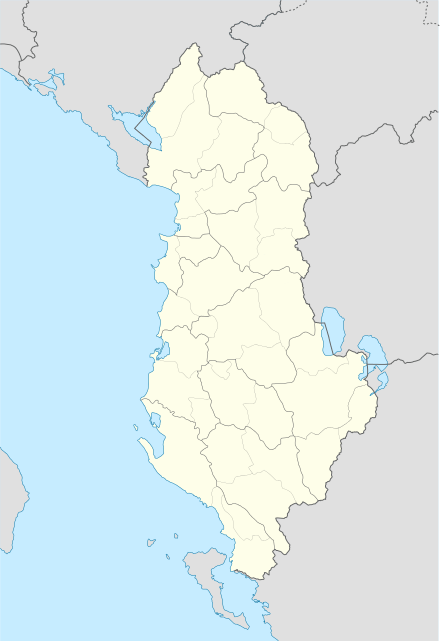 Korçë | |
| Coordinates: 40°37′N 20°46′E | |
| Country | |
| County | Korçë |
| Government | |
| • Mayor | Sotiraq Filo (PS) |
| Area | |
| • Municipality | 806.67 km2 (311.46 sq mi) |
| Elevation | 850 m (2,790 ft) |
| Population (2011) | |
| • Municipality | 75,994 |
| • Municipality density | 94/km2 (240/sq mi) |
| • Municipal unit | 51,152 |
| Demonym(s) | Korçar (m) Korçare (f) |
| Time zone | UTC+1 (CET) |
| • Summer (DST) | UTC+2 (CEST) |
| Postal Code | 7001–7004 |
| Area Code | (0)82 |
| Vehicle registration | AL |
| Website | Official Website |
Name
Korçë is named differently in other languages: Aromanian: Curceaua or Corceao; Serbian, Bulgarian and Macedonian: Горица, Goritsa; Greek: Κορυτσά, Korytsa; Italian: Coriza; Turkish: Görice. The current name is of Slavic origin. The word "gorica" means "hill"[4] in South Slavic languages, and is a very common toponym in Albania and Slavic countries (e.g. Podgorica in Montenegro, Gorizia, Dolna Gorica in the Pustec municipality, and so on). It is diminutive of the Slavic toponym "gora", meaning mountain, which is also found in placenames throughout Slavic countries as well as non-Slavic countries like Albania, Greece and Italy.
History
Middle Ages and Ottoman period
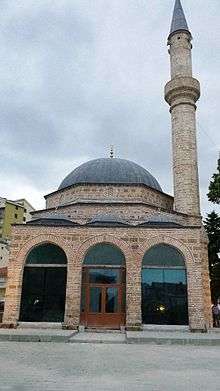
From the 13th century it was a small settlement called Episkopi (Greek: Επισκοπή, "bishopric").[5] The modern town dates from the 1480s, when Iljaz Hoxha, during the reign of Ottoman Sultan Bayezid II, developed Korçë after becoming its administrator and building a mosque bearing his name.[5][6] Korçë was a sandjak of the Manastir Vilayet in the Ottoman Empire as Görice.[7]
The city started to flourish when the nearby town of Moscopole was raided by the Muslim Albanian troops of Ali Pasha at 1788.[8][9] Korçë grew as part of its population came from nearby Moscopole.[10] Greek sources (Liakos and Aravandinos) have noted of the Korçë Aromanian populations' origins that in addition to many being from Moscopole, others settled during a time of calm and were from the village of Shalës, Kolonjë and established the market district of Korçë known as Varosh.[11] Aromanians from the Arvanitovlach subgroup that in the early 19th century arrived to the Korçë area played a significant role in establishing the Korçë Christian urban class.[11] In Psalidas' work Geography from 1830 noted that in the district of Varosh in Korçë, 100 Aromanian families lived there.[11]
According to French diplomat François Pouqueville there were 1,300 families living in the city in 1805 with two thirds of them being Christian.[12] Korçë went from having a population of 8,200 (1875) to 18,000 (1905) and of those 14,000 were regarded as Greek and the rest as Albanian.[10] Of those considered as Greek in Korçë, this was because they adhered to Orthodox Christianity, but Michael Palairet argues that most were Aromanians (Vlachs).[10] Other sources however have characterized the population as primarily ethnic Albanian in the early 20th century,[13] while others as Greek.[12] Greek was the language of the elite and the majority of the Aromanian population engaged in commerce, crafts and international trade becoming one of the wealthiest communities in Epirus and Macedonia.[10] Albanians of Korçë engaged mostly in stockbreeding, agriculture and were poor.[10] The inhabitants of the city spoke both Albanian and Greek.[12]
Korçë's cultural isolation was reduced due to Greek schools, the first one being founded in the city at 1724.[14][15] Subsequently, Muslim Albanian revolutionary intellectuals from the city emerged in the 1840s that wanted to preserve a Muslim Albania within a reformed Ottoman state.[15] Due to increasing Hellenisation by the 1870s, those sentiments became replaced with the concept of an Albanian nation based on linguistic and cultural factors through struggle against a collapsing Ottoman Empire.[15] During the late Ottoman era, Orthodox Albanians involved in the Albanian National Awakening came mainly from Korçë and its surrounding areas.[16] On the other hand, the city council of Korçë, known as demogerontia (Greek: Δημογεροντία), and the metropolitan bishop of the city who identified as Greeks sent a secret memorandum to the foreign office department of Greece suggesting various ways to tackle activities by Albanian nationalists.[17] In 1885, Jovan Cico Kosturi became the founder of a committee called the Albanian Cultural Society, along with co-founders Thimi Marko and Orhan Pojani, but the formation of the organization was suppressed by both the Ottoman and Orthodox Church authorities, so it went underground and carried on its activities as the Secret Committee of Korça (Albanian: Komiteti i Fshehtë i Korçës),[18] and two years later, in March 1887, with the help of the Frashëri brothers, the Secret Committee set up the first Albanian school.[19]
In the late Ottoman period, inhabitants from Korçë and surrounding areas emigrated abroad for economic opportunities, often by the Orthodox community who mainly as qualified craftsmen went to Romania, Greece and Bulgaria while Muslims went to Istanbul performing mainly menial labour work.[20] Late nineteenth century Albanian migration to the United States consisted mainly of Orthodox Albanians from Korçë and surrounding areas who went to work there, save money and intending to eventually return home.[21]
Modern era
Ottoman rule over Korçë lasted until 1912; although the city and its surroundings were supposed to become part of the Principality of Bulgaria according to the Treaty of San Stefano in 1878, the Treaty of Berlin of the same year returned the area to Ottoman rule.[22] In 1910 the "Church Alliance" of local Orthodox Albanians led to the proclamation of an Albanian church by Mihal Grameno, but this effort was too isolated to affect the population.[23][24] Korçë's proximity to Greece, which claimed the entire Orthodox population as Greek, led to its being fiercely contested in the Balkan Wars of 1912–1913. Greek forces captured Korçë from the Ottomans on 6 December 1912 and afterwards proceeded to imprison the Albanian nationalists of the town.[25] Its incorporation into Albania in 1913 was disputed by Greece, who claimed it as part of a region called 'Northern Epirus', and resulted in a rebellion by the Greek population residing in the region of Korçë, who asked the intervention of the Greek army.[26] This rebellion was initially suppressed by the Dutch commanders of the Albanian gendarmerie, that consisted of 100 Albanians led by the Orthodox Albanian nationalist Themistokli Gërmenji, and as a result the local Greek-Orthodox bishop Germanos and other members of the town council were arrested and expelled by the Dutch.[27][28]
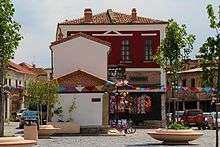
However, under the terms of the Protocol of Corfu (May 1914), the city became part of the Autonomous Republic of Northern Epirus inside the borders of the principality of Albania,[29] while on 10 July 1914 the Greek Northern Epirote forces took over the city.[30] Under Greek occupation, for the purpose of convincing the Congress of London of Greek expansionist claims, the Greek authorities took a census, which counted 15,453 inhabitants in the city, of which 11,453 were Greeks and the rest 4,000 Albanians; however according to Lampros Psomas the census did not inquire about ethnicity, but rather instead explicitly had all Christians renamed "Greeks" and all Muslims changed to "Albanians", by religious criteria alone.[31]
World War I
In October 1914 the city came again under Greek administration. During the period of the National Schism (1916) in Greece, a local revolt broke out, and with military and local support Korçë came under the control of Eleftherios Venizelos' Movement of National Defence, overthrowing the royalist forces.[32] However, due to developments in the Macedonian Front of World War I the city came soon under French control (1916–1920).
The French initially awarded control of Korçë and the surrounding area to Greek allies, but Albanian çeta guerilla bands led by Themistokli Gërmenji and Sali Butka fought against Venizelist forces for Albanian self-administration.[33] Those Albanian bands burned Moscopole and threatened that Korcë would share the same fate. Meanwhile the Venizelos Movement of National Defence was unable to dispatch reinforcements to the region, but also French General Sarrail demanded for strategic reasons the withdrawal of the local Greek garrison.[34] After coming to the conclusion that the local Albanians thoroughly disliked the Greek administration of the area[35], on December 8, 1916, Sarrail cabled that French military policy should change to support the Albanian nationalist uprising; by converting the Albanian uprising to the Allied cause, Sarrail hoped to protect his left flank and enable it to join up with the Italians in Vlorë and discourage the Austrians from trying to advance through Albania.[36] Furthermore, a peaceful and stable allied Korçë under French influence would reduce the number of troops the French army needed to commit to hold the area.[36]
On the 10th of December 1916, fourteen Albanian delegates, including seven Muslims and seven Christians, proclaimed the Autonomous Albanian Republic of Korçë.[36] The French agreed to these demands and the fourteen representatives of Korçë and Colonel Descoins signed a protocol that proclaimed the Autonomous Albanian Republic of Korçë under the military protection of the French army and with Themistokli Gërmenji as president.[27][33][37] The French pursued policies which strengthened expressions of Albanian nationalism.[38] Greek schools were closed down, Greek clergy and pro-Greek notables expelled while allowing Albanian education and promoting Albanian self-government through the autonomous Korçë republic,[38] although Greek schools were reopened after a year and two months in February 1918.[36] Another factor that reinforced Albanian sentiments among the population was the return of 20-30,000 Orthodox Albanian emigrants mainly to Korçë and the surrounding region who had attained Albanian nationalist sentiments abroad.[39] The change in French policy to support the Albanians did create some tensions between France and Italy; the French assured the Italians that they did not have any territorial claims on either Korçë; General Sarrail's reports insisted that the local Albanians had proclaimed the republic, then asked for it to be put under French protection, and that Descoins had merely complied with the wishes of the local population.[36]
On February 16, 1918, Sarrail's successor officially abrogated the proclamation, and following the re-entry of Greece into the war, made concessions to Greek interests including the reopening of Greek schools, but the Albanians were assured that this did not threaten their independence.[36] The Autonomous Albanian Republic of Korçë remained a reality on the ground, continuing to rule its territory and fly its flag, while inter-religious cooperation was also maintained with both Muslims and Christians being grateful to the French for allowing them to continue their self-governance without much interference.[36]
The Autonomous Republic of Korçë was greatly important for the Albanian nationalist movement, as it demonstrated to the world a resurgence in power for Albanian nationalism in one of the areas where it had been the strongest before the war, and it also demonstrated the successful cooperation of Albanian Christians and Muslims in governance.[36] The government is considered to have been a successful experiment in Albanian self-administration, as the French allowed the entity to "act as if it were an independent state", minting its own coinage, introducing its own flag, and printing its own stamps. According to Stickney, the republic gave Albanians the opportunity for self-government under the light tutelage of the French, and they were able to build a state in the absence of the great power rivalry that had beset King Wilhelm's earlier government.[36] However, this French initiative of Albanian self-rule ended without success and the head of this Republic was shot as an Austrian spy.[40]
The Conference of ambassadors considering Albania's claims to the area commissioned a League of Nations report consisting of three on the ground commissioners in December 1921.[41] One commissioner, Finnish professor J. Sederholm, according to Lambros Psomas based on biased pro-Albanian reports,[42] noted in 1922 that Korçë's population was "entirely Albanian; the numbers of Greeks being insignificant"[41] and continued that "there are, however, amongst the population two parties, — one nationalist and the other Grecophile"[43] It ultimately remained part of Albania, as determined by the International Boundary Commission, which affirmed the country's 1913 borders. Although assurances were given in the Paris Peace Conference by Albanian officials for the recognition of the Greek minority, during the 1920s Greek speech was prohibited in local education, religious life and in private within Korçë.[44][45] At November 1921 the Albanian authorities expelled the Greek Orthodox metropolitan bishop Jakob. This event triggered demonstrations by the Orthodox community of the city.[46] Immigration quotas during 1922-4 restricted former migrants returning to the United States and Korçë residents instead migrated to Australia to Moora, Western Australia and Shepperton, Victoria working in farming and agriculture related employment.[21]
Education
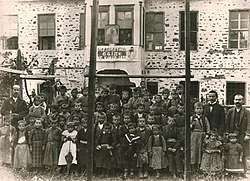
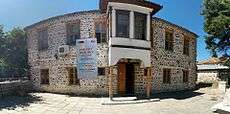
At beginning of the 18th century the inhabitants of Korçë attended the schools of nearby Moscopole.[14] The first school, a Greek language school, in the city was established in 1724 with the support of residents of nearby Vithkuq.[14][47] This school was destroyed during the Greek War of Independence but it reopened in 1830. In 1857 a Greek school for girls was operating in the city.[48] During the 19th century various local benefactors such as Ioannis Pangas and Anastas Avramidhi-Lakçe donated money for the promotion of Greek education and culture in Korçë, such as the Bangas Gymnasium.[49][50] Greek education was also financed by members of the diaspora in Egypt.[14] Similarly, kindergartens, boarding and urban schools, were also operating in the city during this period.[14] Under these developments, a special community fund, named the Lasso fund, was established in 1850 by the local Orthodox bishop Neophytos,[51] in order to support Greek cultural activity in Korçë.[52] At the eve of the Balkan Wars (1912) the total number of students attending Greek education in the city numbered 2,115.[53]
Around 1850, Naum Veqilharxhi created an Albanian alphabet in which a few small books were published and the script briefly flourished in Korçë.[10] At the end of the 19th century local Albanians expressed a growing need to be educated in their native language.[54] The Albanian intellectual diaspora from Istanbul and Bucharest initially tried to avoid antagonism towards the notables of Korçë, who were in favor of Greek culture. Thus they suggested the introduction of Albanian language in the existing Greek Orthodox schools, a proposal which was discussed with the local bishop and the city council, the demogeronteia, and finally rejected by the Ecumenical Patriarchate of Constantinople.[55] In the late 1870s the Albanian Committee of Patriots devised a Latin-based Albanian script which was also adopted by British and U.S. Protestant missionaries [10]
The Central Committee for Defending Albanian Rights founded in the late 1870s promoting Albanian cultural development set up an Albanian secondary school for boys.[10] The founding in 1884 of the boy's secondary school is regarded as the first Albanian school in Korçë[10] and established in 1887 by the Drita (English: the Light) organization and funded by notable local individuals. Its first director was Pandeli Sotiri.[55][56] Naim Frashëri, the national poet of Albania played a great role in the opening of the school.[57] As a high-ranking statesman in the ministry of education of the Ottoman Empire he managed to get official permission for the school.[57] The Ottoman authorities gave permission only for Christian children to be educated in Albanian, but the Albanians did not follow this restriction and allowed also Muslim children to attend.[57] It survived until 1902 under the teachers Leonidis and Naum Naça who were arrested and declared as traitors by Ottoman authorities at the request of Greek clergy with the school being closed down, vandalised and wrecked.[10] Albanian efforts for an Albanian school are represented in Greek sources as a failure due to weak demand and limited funding, but Palairet notes that Greek interference undermined the school.[10][57] In the late 1880s Gjerasim Qiriazi began his Protestant mission in the city. He and fellow members of the Kyrias family established Albanian speaking institutions in Korçë, with his sister Sevasti Qiriazi founding the first Albanian girls school in 1891.[20] It was started by Gjerasim Qiriazi and later run by his sisters, Sevasti and Parashqevi Qiriazi, together with Polikseni Luarasi (Dhespoti). Later collaborators were the Rev. & Mrs. Grigor Çilka and Rev & Mrs. Phineas Kennedy of the Congregational Mission Board of Boston. Both schools were closed by the Ottoman authorities during 1902-1904.[58]
When the city was under French administration in 1916 (the Republic of Korçë), Greek schools were closed and 200 Albanian schools were opened.[35] In the city of Korçë itself, four primary schools opened, and one secondary school opened and functioned quite successfully.[35] A plebiscite was held and voters indicated that they wanted the Albanian schools to stay open.[35] However, a few months later Greek schools were reopened as a reward and result of Greece's adherence to the Entente alliance along with France.[59] Particularly relevant was the opening in 1917 of the Albanian National Lyceum.
From World War II to modern era
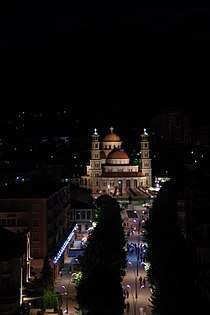
Italian forces occupied Korçë in 1939, along with the rest of the country. During the Greco-Italian War it became the main forward base of the Italian air force. Nevertheless, the city came under the control of the advancing Greek forces, on November 22, 1940, during the first phase of the Greek counter-offensive.[60] Korçë remained under Greek control until the German invasion of Greece in April 1941. After Italy's withdrawal from the war in 1943, the Germans occupied the town until October 24, 1944.
During the occupation, the city became a major centre of Communist-led resistance to the Axis occupation of Albania. The establishment of the Albanian Party of Labour—the Communist Party—was formally proclaimed in Korçë in 1941. Albanian rule was restored in 1944 following the withdrawal of German forces.
The period of the People's Socialist Republic of Albania was a difficult time in the region. President Enver Hoxha targeted the rich, despite the fact that they had fought for the creation of the Communism in Albania by fighting against the Fascist occupations. Right after World War II many people fled to Boston, United States joining a community of the Albanian-Americans, who had previously emigrated there.[61]
After 1990 Korçë was one of the six cities where the New Democratic Party won all the constituencies. Popular revolts in February 1991 ended with the tearing down of Hoxha's statue. After the fall of communism, the city fell into disregard in many aspects. However following the 2000s, the city experienced a makeover as main streets and alleys started to be reconstructed, locals began to renovate their historic villas, a calendar of events was introduced, building façades painted, and city parks reinvigorated. The European Union is financing the renovation of the Korça Old Bazaar while the city centre was redesigned, and a watch tower constructed.
Geography
Climate
Korçë has a transitional Mediterranean climate (or continental Mediterranean climate) with high temperature amplitudes. The hottest month is August (25 °C (77 °F)) while January (2 °C (36 °F)) is the coldest. The city receives around 830 millimeters (33 in) annual precipitation with summer minimum and winter maximum, which makes it easily the driest major city in generally humid Albania, owing to the rain shadow of the coastal mountains. The temperatures in Korçë generally remain cooler than the western part of Albania, due to the middle altitude of the plain in which it is situated, but it receives about 2300 hours of solar radiation per year, so its temperatures are higher than those in Northeastern Albania. Temperatures can still reach up to 40 °C (104 °F) or higher on occasions.
| Climate data for Korçë | |||||||||||||
|---|---|---|---|---|---|---|---|---|---|---|---|---|---|
| Month | Jan | Feb | Mar | Apr | May | Jun | Jul | Aug | Sep | Oct | Nov | Dec | Year |
| Average high °C (°F) | 4.7 (40.5) |
6.7 (44.1) |
10.0 (50.0) |
13.8 (56.8) |
19.5 (67.1) |
23.9 (75.0) |
26.8 (80.2) |
26.3 (79.3) |
22.1 (71.8) |
16.1 (61.0) |
10.4 (50.7) |
5.9 (42.6) |
15.5 (59.9) |
| Daily mean °C (°F) | 0.9 (33.6) |
2.8 (37.0) |
5.4 (41.7) |
8.7 (47.7) |
13.8 (56.8) |
17.6 (63.7) |
19.9 (67.8) |
19.3 (66.7) |
15.7 (60.3) |
10.9 (51.6) |
6.4 (43.5) |
2.3 (36.1) |
10.3 (50.5) |
| Average low °C (°F) | −2.9 (26.8) |
−1.1 (30.0) |
0.8 (33.4) |
3.6 (38.5) |
8.1 (46.6) |
11.3 (52.3) |
13.0 (55.4) |
12.4 (54.3) |
9.4 (48.9) |
5.8 (42.4) |
2.4 (36.3) |
−1.2 (29.8) |
5.1 (41.2) |
| Average precipitation mm (inches) | 80 (3.1) |
68 (2.7) |
65 (2.6) |
73 (2.9) |
73 (2.9) |
38 (1.5) |
40 (1.6) |
40 (1.6) |
54 (2.1) |
99 (3.9) |
108 (4.3) |
87 (3.4) |
825 (32.6) |
| Source: [62] | |||||||||||||
Demographics
Korçë is the 7th populous city in Albania and the largest city in the Korçë County. In 2007, the population of the city was about 86,176 inhabitants. According to the Institute of Statistics (INSTAT), the city of Korçë include 51,683 (25,478 male; 26,205 female) people as of the 2011 Census.[63] The city of Korçë was one of the major centres of the Greek minority in southern Albania, the other being Gjirokastër.[64] and has been listed among cities in Albania which have large Greek populations, along with other cities such as Vlorë, Sarandë, and Shkodër.[65] Aromanians of Korçë live mainly in one neighborhood of the city where they speak Aromanian, have Aromanian cultural associations that are divided between pro-Romanian and Greek factions, church liturgy in Aromanian and maintain cultural and economic connections to Romania and Greece.[66] Romani also inhabit the city, in particular the Kulla e Hirit neighborhood and their presence in the city mainly dates to the early 20th century when they migrated from Turkey to Florina and ultimately Korçë.[67]
Religion
For centuries Korçë has been an important religious centre for both Orthodox Christians and Muslims,[68] hosting a significant Orthodox community as well as significant Sunni and Bektashi communities in and around the city. The main centre of the Bektashis of the area is the Turan Tekke. In modern days, there are also smaller numbers of Catholics[69] and Protestants in the city, as well the irreligious. The second Albanian Protestant church was opened in Korçë.[70] In 1940, Korçë's Evangelical Church was closed down by the Italian fascist forces.[71]
The city was initially part of the Metropolis of Kastoria (15th century), but in the early 17th century became the seat of an Orthodox bishop and in 1670 was elevated to metropolitan bishopric.[72][73] The city remained entirely Christian until the first half of the 16th century.[73] The Orthodox cathedral of saint George, a significant landmark in the city, was demolished by the authorities of the People's Republic of Albania during the atheistic campaign.[74] Funding for the construction of an Orthodox church came from Romanian and Aromanian businessmen.[66]
Islam entered the city in the 15th century through Iljaz Hoxha, an Albanian jannissary, who actively participated in the Fall of Constantinople.[75] One of the oldest mosques in Albania was built by Iljaz Hoxha in 1484, the Iliaz Mirahori Mosque.[76] The Romani population of Korçë consists of Muslims, who in the 1920s maintained their own mosques in the city, while there are also Orthodox Christian Roma in the city's Varosh neighbourhood.[67]
Economy
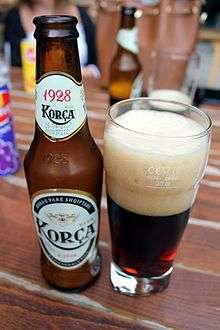
During the 20th century, Korçë gained a substantial industrial capacity in addition to its historic role as a commercial and agricultural centre. Local industries include the manufacture of knitwear, rugs, textiles, flour-milling, brewing, and sugar-refining. The city is home to the nationally famous Birra Korça.
According to official reports the city enjoys one of the lowest unemployment rates in the country. The majority of foreign investment comes from Greek, as well as joint Albanian-Greek enterprises.[14][77]
Culture
Korça is known as the southern Albania’s intellectual capital[78] and is also regarded as the Albanian cultural metropolis.[79]
Modern education
The city is home to Fan Noli University, founded in 1971, which offers several degrees in the humanities, sciences and business. The University includes a school in Agriculture, Teaching, Business, Nursing, and Tourism.
With the prohibition of Greek education in the city, at c. 1922, there was a constant demand for the reopening a Greek school.[80] After the collapse of the Socialist Republic, part of the local communities expressed a growing need to revive their cultural past, in particular with the reopenning of Greek language institutions.[14] In April 2005 the first bilingual Greek-Albanian school opened in Korçë after 60 years of prohibition of Greek education.[81] In addition, a total of 17 Greek language institutes are functioning in the city.[14]
Museums
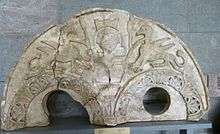
Korçë is referred to as the city of museums. The city hosts two major museums such as the National Museum of Medieval Art and National Museum of Archeology. The National Museum of Medieval Art has rich archives of about 7000 icons and 500 other objects in textile, stone and metal. The first Albanian School as well as the residence and gallery of painter Vangjush Mio function as museums. The Bratko Museum and the Oriental Museum are also located in the city.
Korçë has a city theatre, the Andon Zako Çajupi Theatre, which started its shows in 1950 and has been working uninterruptedly since.[82]
Sport
One of Korçë's most popular sport is football. Its most popular soccer club is Skënderbeu Korçë and was formed on 15 April 1909 under the name Vllazëria by politician and poet Hilë Mosi.[83] They were Albanian Champions in 1933 and recently, in 2011, 2012, 2013, 2014, 2015 and 2016. In 2015 the club became the first Albanian side to reach the play-off round of the UEFA Champions League but they lost to Dinamo Zagreb and dropped into the UEFA Europa League, and became the first Albanian club to qualify for the group stage of European competition.
Architecture
Korça being one of the important cultural and economic centers in the country is known for its low houses and villas, paved with cobblestone.[84]
Cultural events and music
It is the home of the largest carnival in Albania that takes place before Orthodox Easter, a tradition dating back 40 years.[85] Musically, the city is known for the local songs, called serenata.
Panorama
International relations
Korçë is twinned with:
Notable people
See also
References
- Law nr. 115/2014 Archived 2015-09-24 at the Wayback Machine
- "Population and housing census - Korçë 2011" (PDF). INSTAT. Retrieved 2019-09-25.
- "Correspondence table LAU – NUTS 2016, EU-28 and EFTA / available Candidate Countries" (XLS). Eurostat. Retrieved 2019-09-25.
- Law, Gwilim (2010). Administrative Subdivisions of Countries. Page 22
- Taylor, Stephen (1932). Handbook of Central and East Europe: 1932–33. Zürich: Central European Times Publishing Company. p. 21.
"It was an unimportant little village, named Episkopi until in 1487, when the Albanian Kodja Mirahor Ilias Bey became its administrator and founded the mosque called after him
- "Korçë". Encyclopædia Britannica. Retrieved 15 January 2016.
- Masud, Muhammad (2006). Dispensing justice in Islam: Qadis and their judgements. BRILL. p. 283. ISBN 978-90-04-14067-7.
- Princeton University. Dept. of Near Eastern Studies. Princeton papers: interdisciplinary journal of Middle Eastern studies. Markus Wiener Publishers, 2002. ISSN 1084-5666, p. 100.
- Fleming Katherine Elizabeth. The Bonaparte: diplomacy and orientalism in Ali Pasha's Greece. Princeton University Press, 1999. ISBN 978-0-691-00194-4, p. 36: "...Moschopolis, destroyed by resentful Muslim Albanians in 1788"
- Palairet, Michael (2016). Macedonia: A Voyage through History (Vol. 2, From the Fifteenth Century to the Present). Cambridge: Cambridge Scholars Publishing. pp. 114–115. ISBN 9781443888493.
Of these, 14,000 were "Greek", the rest Albanian. "Greek" means that they adhered to the Orthodox Church, but they were probably predominantly Vlach, and enjoyed strong links with Romania...Progress was "spurred on by a climate of ethnic rivalry with lethal characteristics". A pioneering effort by one Vekilcharje in about 1850 produced an Albanian alphabet, in which a few small books were printed. It flourished briefly at Korçë, but its creator is believed to have been poisoned by the Greek Patriarch. Subsequent impetus for Albanian language education came from the American and British Protestant missions. In the late 1870s, a Latin-based Albanian alphabet was devised by a Committee of Albanian Patriots based on Constantinople, and was adopted by the British and Foreign Bible Study. In the early 1880s, a rich Vlach emigre named Anastasios Avramidis-Liaktis announced his intention of making over his fortune for the benefit of people of Korçë, and Albanians (presumably the Committee) approached him for funds to open an Albanian school there. The project caused inter-communal tension which led to the donor proposing instead a Greek school with Albanian teaching twice a week. Even this diluted scheme was dropped, as Avramidis-Liaktis learned to act "according to a purely Greek consciousness". Despite this, in 1884 the Albanian Committee set up a boys school. Greek sources represent Albanian efforts to compete in establishing schools as failing because of weaker demand for education and smaller funding, but once more, Greek interference undermined the school: it "struggled in the face of Greek anathemas". It is, however, the first Albanian school to be founded, and the building in Korçë (or a facsimile thereof) is preserved as a museum. It survived till 1902, under teachers Naum and Leonidas Natcha, but they were incarcerated as traitors (to the Ottoman state) at the behest of the Greek clergy, and their school was wrecked and vandalized. An American inspired Protestant school was founded, also at Korçë in 1889, but it struggled in the face of similar pressrues.
CS1 maint: ref=harv (link) - Koukoudis, Asterios (2003). The Vlachs: Metropolis and Diaspora. Thessaloniki: Zitros Publications. ISBN 9789607760869.CS1 maint: ref=harv (link) pp. 297-298. "Regarding the origins of the urban Vlachs of Korçë, Liakos notes that, according to a written source dating to 1867, apart from the Moschopolitans, there were also Vlachs from the village of Shalës in Kolonjë, which he describes as a former Arvanitovlach settlement. Aravandinos reports that the people from Shalës and many from Moschopolis probably settled in Korçë in an organised way, when the area was fairly calm after 1834. These settlers established the market district in Korçë known as Varossi. If we bear in mind that the Arvanitovlachs who arrived in the Korçë area in the early nineteenth century played a considerable part in establishing the Christian urban class in Korçë, then we may, rather cautiously perhaps, suppose that one of the places from which they came was Shalës."; p. 361. "Indeed, according to Psalidas's Geography, in around 1830, after the Greek War of Independence and a period of renewed insecurity,... And in the same period, 100 Vlach families were living in the Varossi district of Korçë."
- Ismyrliadou, Adela (1996). "Educational and Economic Activities in the Greek Community of Koritsa during the Second Half of the Nineteenth Century". Balkan Studies. 1 (37): 235.
According to the French traveller Pouqueville, who visited the city in 1805... 14.000 of whom were Greek and 4.000 Albanian... spoke Greek and Albanian as well.
- Muin Çami. Shqiptarët dhe francezët në Korçë (1916 – 1920). Dituria: Tirana 1999. Page 132: "....ushtarakët francezë që qëndruan në Korçë dhe që mundën kështu të njiheshin me karakterin etnik shqiptar të popullsisë dhe me aspiratat e vërteta kombëtare të shumicës dërrmuese të kësaj popullsie. Lajmi i largimit të trupave franceze dhe i zëvendësimit të tyre me ato greke e vuri qeverinë shqiptare dhe veçanërisht rrethet patriotike në trevën e Korçës, përpara një sprove të rëndë."
- Qaja, Evis (2006). Το Ζήτημα της Εκπαίδευσης στην Ελληνική Μειονότητα και οι Δίγλωσσοι Μετανάστες Μαθητές στα Ελληνικά Ιδιωτκά Σχολεία στην Αλβανία [Education Issues in Greek Minority and Bilingual Immigrant Students at Private Greek Schools in Albania] (in Greek). University of Thessaloniki. pp. 118–121. Retrieved 6 February 2013.
- Turnock, David (2004). The economy of East Central Europe, 1815-1989: Stages of transformation in a peripheral region. London: Routledge. p. 52. ISBN 9781134678761.CS1 maint: ref=harv (link)
- Pipa, Arshi (1989). The politics of language in socialist Albania. Boulder: East European Monographs. p. 196. ISBN 9780880331685.CS1 maint: ref=harv (link) "Most of the Tosk Orthodox patriots came from Korçë and its regions."
- Skoulidas, Ilias (2001). "The Relations between the Greeks and the Albanians during the 19th Century: Political Aspirations and Visions (1875 - 1897)". Didaktorika.gr (in Greek). University of Ioannina: 252–253. doi:10.12681/eadd/12856. Retrieved 24 June 2017.
κέντρου για την προώθηση των σχεδίων των αλβανών εθνικιστών, προκάλεσε την αντίδραση του μητροπολίτη της πόλης καθώς και των μελών της δημογεροντίας που είχαν ελληνική εθνική συνείδηση. ...πάρουν οι σχετικές ενέργειε
- Frashëri, Kristo. Rilindja Kombetare Shqiptare. Page 41: "1885, at Korça there was formed a secret committee headed by Jovan Cico Kosturi with co-members Thimi Marko and Orhan Pojani, which assumed the mission to organize in the interior of Albania an Albanian Cultural Society. But due to the Ottoman reaction and phanariot church persecutions, the said society could not be founded. Nevertheless, the Secret Committee of Korça continued its activity for a long time in a clandestine and illegal way".
- Frashëri, Kristo. Rilindja Kombetare Shqiptare. Page 43: "the Secret Committee of Korça, with the help of Naim Frashëri and Sami Frashëri, set up in the city of Korça, on 7th of March 1887, the first Albanian National School. The first teachers of this sçhool were Pandeli Sotiri (during the first year) and later Petro N. Luarasi and Nuchi Nachi."
- Pistrick, Eckehard (2015). Performing nostalgia: Migration culture and creativity in south Albania. Farnham: Ashgate Publishing. p. 54. ISBN 9781472449535.CS1 maint: ref=harv (link)
- Barjaba, Kosta; King, Russel (2005). "Introducing and theorising Albanian migration". In King, Russell; Mai, Nicola; Schwandner-Sievers, Stephanie (eds.). The New Albanian Migration. Brighton-Portland: Sussex Academic. p. 8.CS1 maint: ref=harv (link) "Albanian emigration to the US started in the late nineteenth century, as noted above. Most migrants came from Korçë and other parts of rural southern Albania (figure 1.1). They were predominantly Orthodox young men who intended to return home after they had made some money (Lucas 2002: 14; Nagi 1988: 32—33).... the migration to Australia during 1925—6 of Albanians who had returned from the United States but who could not go back to the US because of that country’s quota laws set in place in 1922—4.... Chain migration was a fundamental driving force behind this migration; once again the Korçë area was the dominant district of origin. Korçë migrants settled above all in Shepperton (Victoria) and Moora (Western Australia), specialising in various farming and agriculture-related jobs."
- "History of Albania, 1878–1912". World History at KMLA. Retrieved 2008-10-08.
- Blumi, Isa (2002). Albanian identities : myth and history. Hurst. p. 55. ISBN 9781850655725.
These efforts, however, were far too isolated to have an impact on how local communities socialised and articulated their identities.
- Blumi, Isa (2001). "Teaching Loyalty in the Late Ottoman Balkans: Educational Reform in the Vilayets of Manastir and Yanya, 1878–1912". Comparative Studies of South Asia, Africa and the Middle East. 21 (1–2): 19. doi:10.1215/1089201x-21-1-2-15.
- Pearson, Owen (2004). Albania and King Zog: independence, republic and monarchy 1908–1939. Albania in the twentieth century. 1. I. B. Tauris. p. 35. ISBN 978-1-84511-013-0.
- Roudometof, Victor (2002). Collective memory, national identity, and ethnic conflict: Greece, Bulgaria, and the Macedonian question. Greenwood Publishing Group. p. 155. ISBN 978-0-275-97648-4.
Subsequently, the Greeks in the regions of Gyrocaster (Argyrokastro) and Korce (Korytza) revolted and asked Greek troops to intervene
- Pearson, Owen (2004). Albania and King Zog: independence, republic and monarchy 1908–1939. I.B.Tauris. p. 103. ISBN 978-1-84511-013-0. Retrieved 4 November 2010.
- Kondis Basil. Greece and Albania, 1908–1914. Institute for Balkan Studies, 1976, p. 130: "The Dutch, having proof that Metropolitan Germanos was chuef instigator of the rising, arrested him and other members of the town council and sent them to Elbasan."
- Valeria Heuberger; Arnold Suppan; Elisabeth Vyslonzil (1996). Brennpunkt Osteuropa: Minderheiten im Kreuzfeuer des Nationalismus (in German). Oldenbourg Wissenschaftsverlag. p. 69. ISBN 978-3-486-56182-1.
- The Ottoman Empire and Its Successors, 1801–1927. William Miller, 1966. ISBN 0-7146-1974-4
- Psomas, Lambros (2008). The Religious and Ethnic Synthesis of Southern Albania (Northern Epirus). Page 253: "The Greeks supported their claims Southern Albania or Northern Epirus, as they call it, based some statistics that they produced. They followed the same policy in the Conference of the Ambassadors in London 1913 (Table 2.2) and the Peace Conference of Paris 1919 as well... The Greeks argued that Southern Albania should be yielded to them for specific historical and geographical They also argued that the inhabitants of the south were Greeks by sentiment. This argument of the sentiment was based the common religion between the Greeks and the Orthodox population of the south. As a result, the Greeks considered a11 Orthodox Albanian, Vlach and Slav-speaking people of the South as ethnically Greeks... Explicitly, the terms Orthodox Christian and Muslim were changed into Greek and Albanian respectively."
- Kondis Basil. The Greeks of Northern Epirus and Greek-Albanian relations. Hestia, 1995, p. 32: ""a rebellion broke out in Korytsa... their loyalty to the National Defence movement."
- Besier, Gerhard; Stokłosa, Katarzyna (2014). European Dictatorships: A Comparative History of the Twentieth Century. Newcastle upon Tyne: Cambridge Scholars Publishing. p. 237. ISBN 9781443855211.CS1 maint: ref=harv (link)
- Kondis, B. (1 January 1989). "The Northern Epirus question during the First World War". Balkan Studies. 30 (2): 348. ISSN 2241-1674. Retrieved 31 March 2020.
- Zavalani, Tajar (2015). Elsie, Robert; Destani, Bejtullah (eds.). History of Albania. p. 160-161. ISBN 978-1507595671.
- Guy, Nicola C. (2008) Ethnic nationalism, the Great powers and the question of Albanian independence, 1912-1921. Doctoral thesis, Durham University. Pages 196-199: Surprisingly, the first significant developments took place in the French occupied zone. On 10 December 1916, fourteen Albanian representatives (seven Christians and seven Muslims) created an administrative council and proclaimed Koritza an autonomous republic. This regime was highly significant for the Albanian nationalist movement, and it was indicative of the resurgence of Albanian nationalism in one of the areas where it had been strongest before the war. According to Jan Karl Tanenbaum, this regime `acted as if it were an independent state, for it minted its own coinage, printed its own stamps, and introduced its own flag'. 438 Stickney considered that the republic gave the Albanians the opportunity for self-government under the French, which she described as the `tutelage of those well disposed toward and more experienced than themselves'. Overall, it was a successful experiment in which Muslims and Christians worked together in the administration, and, in particular, without all the complications of great power rivalry and intrigue that had so beset Wilhelm's regime. The great powers appeared far from uninterested. It has been suggested that the French became a new force in Albania, and showed new interest in it becoming an independent state. In reality, as H. James Burgwyn in particular has shown, French activity was only at a local level, and for strategic as opposed to moral or national reasons. Colonel Henri Descoins, the French commander in Koritza, signed a proclamation stating that the regime was to be under French military protection. It was suspected that Descoins was even the author of the document. For the week prior to the proclamation, General Maurice Sarrail, Commander of the Eastern Army, and Descoins were in repeated communication about this project. On 8 December 1916, Sarrail had cabled that the Albanian nationalists should be supported. Tanenbaum contends that Sarrail instigated this action to protect Koritza from Venizelist forces, which had prompted guerrilla warfare by some Albanians. By expelling the Greeks and converting the Albanian nationalists to the Allied cause, Sarrail hoped to protect the left flank. A peaceful and stable Koritza under French control would reduce the number of French troops needed, discourage the Austrians from moving into southern Albania and enable the Eastern Army's left flank to join up with Italian troops in Valona... (p198) ... Irrespective of its cause, this move generated much tension with the Italians. Briand repeatedly assured Sonnino that the French had no designs on either Albania or Koritza. It appears that, even by March 1917 (when he resigned as Premier), Briand had not yet received full information. Sarrail's reports still insisted that the Albanians had proclaimed the republic, then asked for it to be put under French protection, and that Descoins had merely complied with the wishes of the local population. Sarrail wrote that he had `always let the population do what it wanted; ... it does not behove me to meddle in the Greek and Balkan internal political question. Koritza wanted to be independent: now it is, 'However, the ramifications of the Koritza declaration would continue to reverberate well into 1917 and beyond. On 16 February 1918, Sarrail's successor eventually abrogated the proclamation. The Quai d'Orsay was far from keen to have the Albanian nationalist movement develop too far under French influence, in case it jeopardised their more important goals regarding Greece. Changes were only nominal: Greek schools re-opened and Essad was prevented from transferring his government to the town, as sops to the Italians and Greeks, following the latter's eventual entry into the war. But, Koritza retained essentially the same government, and the republic's flag continued to fly over the town. Inter-religious co-operation was maintained, and both faiths were thankful to the French for the opportunity of self-government without much interference. The Albanians were also assured that this action did not threaten their independence.
- Schmidt-Neke, Michael (1987). Enstehung und Ausbau der Königsdiktatur in Albanien, 1912–1939. Oldenbourg Wissenschaftsverlag. p. 43. ISBN 978-3-486-54321-6. Retrieved 8 November 2010.
- Psomas 2008, pp. 263–264, 272, 280.
- Psomas, Lambros (2008). "The Religious and Ethnographic Synthesis of the Population of Southern Albania (Northern Epirus) in the Beginning of the 20th Century" (PDF). Theologia. 79 (1): 263–264, 268, 280–281.CS1 maint: ref=harv (link)
- Winnifrith, Tom (2002). Badlands, borderlands : a history of Northern Epirus/Southern Albania. Duckworth. p. 132. ISBN 9780715632017.
The French experiment briefly with Albanian self-rule, was not a success, and the President of the Republic of Korce, Themistocles Germenji, was eventually shot as an Austrian spy.
- Austin, Robert Clegg (2012). Founding a Balkan State: Albania's Experiment with Democracy, 1920-1925. Toronto: University of Toronto Press. p. 93. ISBN 9781442644359.CS1 maint: ref=harv (link) "One commissioner from the delegation Sederholm noted the population of Korçë being “entirely Albanian” with “the number of Greeks there” being “quite insignificant”.... "Joseph Emerson Haven, a U.S. diplomat based in Italy on special detail in Albania during the spring of 1919, had already come to a similar conclusion. In his detailed report on the political situation in the country, Haven suggested that the disputed province of Korçë had roughly 60,000 inhabitants, roughly 18 per cent of whom were in favour of Greek sovereignty. Of those 18 per cent, he argued, half were seeking that end out of fear or had been promised material gain in the form of Moslem land and property.... Haven found that the ‘most intense hatred and loathing exists in Southern Albania for Greece, this hatred being shown by both Orthodox Christians and Musselmen. The cry is “We are Albanians first and religionists second.” With the exception of comparatively few residents in the province of Coritsa [Korçë] and a few towns in the region of Chimara [Himarë], the country is absolutely Albanian in sentiment."
- Psomas, Lampros (3 July 2015). "A Spy in Albania: Southern Albanian Oil and Morton Frederic Eden". International Journal of Intelligence and CounterIntelligence. 28 (3): 16, 19, 590–609. doi:10.1080/08850607.2015.992762. ISSN 0885-0607.
He then probably returned to Korçë, where in January 1922 he, possibly, misinformed Sederholm about Bishop Jacob’s deportation in November 1921.... The image depicted here presents an individual with strong pro-Albanian sympathies and with particular interest in Southern Albania. ... ..He returned to Albania and showed particular interest for Southern Albania passing misleading pro-Albanian information to Ambassador Eyres and, probably, even Commissioner Sederholm.
- Münchner Zeitschrift für Balkankunde (in German). R. Trofenik. 1996. p. 279.
- Winnifrith, Tom (2002). Badlands, Borderlands: A History of Northern Epirus/Southern Albania. Duckworth. p. 135. ISBN 9780715632017.
The Albanians in general and Fan Noli in particular at the time of the Paris Peace Conference had promised to recognize the peculiar status of the Greek minority. This pledge was not honoured. Greek schools were allowed, but only in certain areas. Korce and Permet were excluded.
- Manta, Eleftheria (2005). "Aspects of the Italian Influence upon Greek - Albanian Relations during the Interwar Period". Didaktorika.gr (in Greek). University of Thessaloniki: 56–57. doi:10.12681/eadd/23718. Retrieved 27 June 2017.
- Psomas, Lampros (3 July 2015). "A Spy in Albania: Southern Albanian Oil and Morton Frederic Eden". International Journal of Intelligence and CounterIntelligence. 28 (3): 10, 19, 590–609. doi:10.1080/08850607.2015.992762. ISSN 0885-0607.
...the Albanian authorities, acting fast and without any warning,... Though the reports by locals that reached the League of Nations refuted their assertions
- Basil Kondis. The Greeks of Northern Epirus and Greek-Albanian relations. Hestia, 1995, p. 9: ""The first school of the Hellenic type in Korytsa opened in 1724"
- Sakellariou M. V., Epirus, 4000 years of Greek history and civilization. Ekdotikē Athēnōn, 1997, ISBN 978-960-213-371-2, p. 308
- Basil Kondis. The Greeks of Northern Epirus and Greek-Albanian relations. Hestia, 1995, p. 9 "With the money bequeathed by An. Avramidis two schools of the Hellenic type, a girls' school, and three primary schools were founded"
- Ismyrliadou, Adela; Karathanasis, Athanasios (1999). "Koritsa: Education-Benefactors-Economy 1850–1908". Balkan Studies. 1 (40): 224–228.
Among them benefactors Ioanis Bangas (1814–1895) and Anastasios Avramidis Liaktsis have a definite place...", "General Rules for Public Institutions in the town of Koritsa were drawn up and changed for the better the functioning of the educational estamblishments.
- Ismyrliadou, Adela (1996). "Educational and Economic Activities in the Greek Community of Koritsa during the Second Half of the Nineteenth Century". Balkan Studies. 1 (37): 235–255.
- Sakellariou, M. V. (1997). Epirus, 4000 years of Greek history and civilization. Ekdotike Athenon. p. 255. ISBN 978-960-213-371-2.
- Ismyrliadou, Adela (1996). "Educational and Economic Activities in the Greek Community of Koritsa during the Second Half of the Nineteenth Century". Balkan Studies. 1 (37): 235–255.
... shortly before the collapse of the Ottoman Empire, a second girls’ school opened in Koritsa and the number of pupils rose to 2.115.
- Zhelyazkova, Antonina (1999). "Albanian identities". International centre for minority study and intercultural relations: Sofia, Bulgaria 1999. Page 23-24: "The question of educating Albanians in their mother tongue was raised frequently in the reports of American religious missionaries in the Balkans. In June 1896 Reverend Lewis Bond reported that lessons at the Korça (Korcë) school were conducted in modern Greek, while the local people loved their own tongue, only spoken at home. "The question of the education of the Albanians in their own language was a problem posed many times in the reports of American religious missionaries in the Balkans. In June 1896 Reverend Lewis Bond reported that lessons at the Korça (Korcë) school were conducted in modern Greek, while the local people loved their own tongue which they spoke only at their homes. "Can we do anything for them", asked Reverend Bond. His question obviously remained rhetorical, because three years later he sent another, much more extensive, statement on the issues of the language and education of the Albanians in Korça. He wrote that only at the girls' school, set up by the Protestant community, the training was in Albanian and once more claimed there was no American who would not sympathise with the Albanians and their desire to use their own language."
- Skendi, Stavro (1967). The Albanian national awakening, 1878–1912. Princeton University Press. p. 134.
- Clayer, Natalie (2007). Aux origines du nationalisme albanais: la naissance d'une nation majoritairement musulmane en Europe (in French). KARTHALA Editions. pp. 301–10. ISBN 978-2-84586-816-8.
- Özdalga, Elisabeth (2005). SOAS/Routledge Curzon studies on the Middle East. 3. Routledge. pp. 264–265. ISBN 978-0-415-34164-6.
- Skendi, Stavro (1967). The Albanian national awakening, 1878-1912. Princeton University Press. pp. 136–137.
- Stickney, Edith Pierpont (1924). Southern Albania, 1912–1923. pp. 69–70. ISBN 978-0-8047-6171-0.
several months later, Greek schools were reopened as a result of Greek influence
- Jr, Samuel W. Mitcham (2007). Eagles of the Third Reich men of the Luftwaffe in World War II. Mechanicsburg, PA: Stackpole Books. p. 114. ISBN 9780811744515.
On the 22d they routed the Italian ninth Army at Koritsa (Korçë) and overran their principal forward air base
- Korça – Çelësi turistik (Fatos Baxhaku ed.). Tirana: Botim i Çelësi. 2008. ISBN 978-99956-677-3-3.
- "Climate: Korçë". Climate-Data.org. Retrieved April 30, 2019.
- "Archived copy" (PDF). Archived from the original (PDF) on 12 January 2012. Retrieved 2012-06-21.CS1 maint: archived copy as title (link)
- King, Russell; Mai, Nicola (2008). Out of Albania: From Crisis Migration to Social Inclusion in Italy. Berghahn Books. p. 32. ISBN 9781845455446.
Greek troops entered southern Albania, capturing Korce and Gjirokaster, centres of the Greek-speaking minority in Albania.
- Bugajski, Janusz (1995). Ethnic politics in Eastern Europe: A guide to nationality policies, organizations, and parties. Armonk: ME Sharpe. pp. 271–272. ISBN 9780765619112.
...linguistic rights were largely absent in several cities heavily populated by Greeks, such as Korçë, Himarë, Tepelenë, Fier, Vlorë, Shkodër, Berat, Permët, and Elbasan.
Reprint available here : - Schwandner-Sievers, Stephanie (2002). "Dawn for a 'Sleeping Beauty Nation' – Aromanian Identity Politics and Conflicts in Post-Communist Albania" (PDF). In Kressing, Frank; Kaser, Karl (eds.). Albania–a country in transition. Aspects of changing identities in a south-east European country. Baden-Baden: Nomos-Verlag. pp. 152–153, 158–159. ISBN 9783789076701.CS1 maint: ref=harv (link)
- De Soto, Hermine; Beddies, Sabine; Gedeshi, Ilir (2005). Roma and Egyptians in Albania: From social exclusion to social inclusion. Washington D.C.: World Bank Publications. pp. 9, 231. ISBN 9780821361719.CS1 maint: ref=harv (link)
- John Paxton (1 January 2000). The Penguin encyclopedia of places. Penguin. p. 489. ISBN 978-0-14-051275-5.
Cap. of the Korce region and district in the SE. Pop. (1991) 67,100. Market town in a cereal-growing area. Industries inc. knitwear, flour-milling, brewing and sugar-refining. It was an important Orthodox and Muslim religious centre. The fifth .
- Religion in the 2011 Albanian census-- Catholics make up 1.45% of the population within Korça's municipal boundaries
- "Shfaqja e kishës protestante tek shqiptarët". 12 April 2014. Retrieved 23 September 2017.
- "Histori e shkurtër e Kishës Ungjillore (Protestante) në Shqipëri". Archived from the original on 24 September 2017. Retrieved 23 September 2017.
- Christopoulos, George A. (2000). The splendour of Orthodoxy. Athens: Ekdotike Athenon. p. 492. ISBN 9789602133989.
Even before the town itself was built, in 1490, the district of Korytsa belonged the metropolis of Kastoria, which had itself subordinate to the archbishopric of Ohrid. The metropolis of Korytsa was established early in the seventeenth century, incorporating the sees of Kolonia, Debolis, and Selasphoro (Sevdas). The first well- known bishop of Korytsa (1624 and 1628) was Neophytos. In the year 1670 Parthenios, archbishop of Ohrid, a native of Korytsa, elevated his mother town to a metropolitan seat, its occupant bearing the title of bishop of Korytsa, Selapsphoro and Moshopolis
- Schmitt, Oliver Jens (2010). Religion und Kultur im albanischsprachigen Südosteuropa (1 ed.). Frankfurt am Main: Lang. pp. 37, 79. ISBN 9783631602959.
- Leustean, Lucian; Leustean, Senior Lecturer in Politics and International Relations Lucian (2010-01-21). Eastern Christianity and the Cold War, 1945-91. Routledge. p. 151. ISBN 9781135233822.
Some landmark churches such as the Saint George Orthodox Cathedral in Korce were razed.
- "Iljaz Bej Mirahori". Archived from the original on 2010-01-17. Retrieved 2010-03-25.
- Petersen, Andrew (1994). Dictionary of Islamic architecture. Routledge. p. 10. ISBN 978-0-415-06084-4. Retrieved 2010-06-13.
- Hermine De Soto (2002). Poverty in Albania : a qualitative assessment. Washington, DC: World Bank. p. 32. ISBN 9780821351093.
- Dragicevich, Peter; Vladisavljevic, Brana (2019). Western Balkans (3 ed.). Lonely Planet. p. 80. ISBN 978-1-78868-277-0.CS1 maint: multiple names: authors list (link)
Korça is southern Albania’s intellectual centre and a town with a proud cultural heritage.
- "Ein Später YB-Sieg zum versöhnlichen EL-Abschluss" [A late YB win for a conciliatory EL ending]. 20 Minuten (in German). Switzerland. December 8, 2017. p. 40.
Nach einer unansehnlichen ersten Halbzeit ging die Mannschaft aus der albanischen Kulturmetropole Korça nach 51 Minuten mit ihrem ersten Torschuss in Führung.
- Καγιά, Έβις (2006). Το Ζήτημα της Εκπαίδευσης στην Ελληνική Μειονότητα και οι Δίγλωσσοι Μετανάστες Μαθητές στα Ελληνικά Ιδιωτκά Σχολεία στην Αλβανία (in Greek). University of Thessaloniki. p. 123.
- "Albanische Hefte. Parlamentswahlen 2005 in Albanien" (PDF) (in German). Deutsch-Albanischen Freundschaftsgesellschaft e.V. 2005. p. 32. Archived from the original (PDF) on 2011-07-18.
- History of the A. Z. Çajupi Theatre (Korçë municipality website)
- Historiku i Klubit (Official website) Archived 2015-08-16 at the Wayback Machine
- "Albanian National Tourism Agency".
- "Independent Balkan News Agency".
- "Twinning Cities". City of Ioannina. Retrieved 2009-07-07.
- "Twinning Cities". City of Thessaloniki. Archived from the original on 2009-03-31. Retrieved 2009-07-07.
- Korçë Municipality. "Twin cities" (in Albanian). Korçë Municipality. Archived from the original on 27 November 2012. Retrieved 30 July 2010.
Further reading
- Blocal, Giulia (29 September 2014). "Korça and the hinterlands of South-Eastern Albania". Blocal Travel blog.
- Municipality of Korçë
- N. G. L. Hammond, "Alexander's Campaign in Illyria", The Journal of Hellenic Studies, pp. 4–25. 1974
- James Pettifer, Albania & Kosovo, A & C Black, London (2001, ISBN 0-7136-5016-8)
- François Pouqueville, Voyage en Morée, à Constantinople, an Albanie, et dans plusieurs autres parties de l'Empire othoman, pendant les années 1798, 1799, 1800 et 1801. (1805)
- T. J. Winnifrith Badlands-Borderlands A History of Northern Epirus/Southern Albania (2003)
External links
| Wikimedia Commons has media related to Korçë. |
| Wikivoyage has a travel guide for Korçë. |
- Korçë County Official Tourist Guide
- Beer Fest
- Municipality of Korçë
- . Encyclopædia Britannica (11th ed.). 1911.


